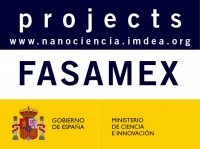FASAMEX Friction at the Nanoscale: anisotropy effects and influence of mechanical excitations
Prof. Enrico Gnecco
-
Funding : Ministerio de Ciencia e Innovación. MAT2011-26312
-
Duration: 2012 - 2012
-
12 months
The main goal of this project was to study anisotropy effects in atomic-scale friction. The investigated surfaces included carbonate minerals, alkali halides, graphene and organic molecules self-assembled on crystal surfaces. An example is given in Fig. 1, where a friction map of CuPc molecules grown on dolomite is shown. Most of the experimental results could be reproduced using the Prandtl-Tomlinson model.
We have also performed nanomanipulation experiments to estimate the shear stress required to detach heteroepitaxially grown nanoislands (Fig. 2) and to relate the trajectories of nanoparticles to the friction force between particles and substrate (Fig. 3). The samples consisted in carbonate minerals and in metal or metalloids deposited on solid lubricants such as MoS2 and graphite.
The influence of mechanical vibrations on friction and the use of anisotropic substrates for nanomanipulation will be systematically explored in the continuation of this bridge project, which retains the same name.

Fig. 1. Friction force map of CuPc molecules on dolomite (104) in water; Fig. 2. Detachment of a calcite island from a kutnahorite substrate; Fig. 3. AFM manipulation of Sb islands on a MoS2 substrate.
http://nanociencia.imdea.org/images/nanociencia/scientific_reports/Scientific-Report-2012.pdf#page=83




